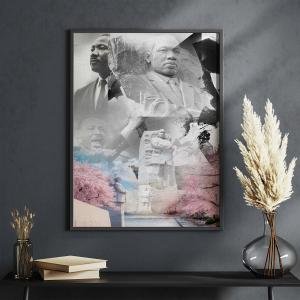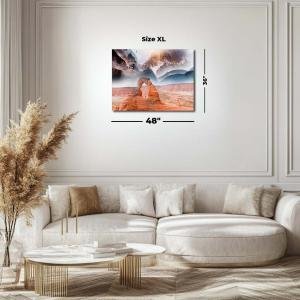Echoes of Vicksburg: The Haunting Legacy of Siege and Sacrifice
This artwork is a reflection of both the tangible history and the emotional weight carried by Vicksburg National Military Park. I wanted to create an image that not only depicts the physical remnants of the Civil War but also captures the emotional and spiritual echoes that still linger over the battlefield today.
Please see Below for Details…
Hotline Order:
Mon - Fri: 07AM - 06PM
404-872-4663
At the center of the image stands the Vicksburg Memorial, a reminder of the heroism and sacrifice made during the Siege of Vicksburg in 1863. The classical architecture is monumental and timeless, serving as a tribute to the soldiers who fought, whether Union or Confederate, during one of the most critical battles of the Civil War. Its columns and stairs ascend, symbolizing the honor bestowed upon those who fought, while also reflecting the challenging and uphill battle that defined this siege.
In the foreground, the cannon represents the raw power and devastation of war. Cannons were crucial during the Siege of Vicksburg, as they were used in the prolonged bombardment of the city. The presence of the cannon in the artwork reminds me of the relentlessness of war, the noise, and the destruction it leaves behind. I chose to give it prominence because it embodies the military might and strategic importance that decided the fate of Vicksburg, changing the course of the war.
The steps and stairs leading up to the memorial are metaphoric of the journey through history, the difficult paths trodden by soldiers, and the enduring struggle for remembrance. Each step represents a moment in time, a life lost, or a battle fought in this war that pitted brother against brother. Climbing these steps could also symbolize the emotional climb one must make to fully grasp the scale of the tragedy and the sacrifice made here.
One of the more ethereal aspects of the piece are the ghostly trees and figures that emerge through the mist. These figures are not fully visible, just as the memory of the soldiers is slowly fading from our present consciousness. I wanted to create a sense of haunting—not in the macabre sense, but as a reminder that the past always lingers, like shadows we can almost see but never fully grasp. The trees represent the passage of time, standing witness to history unfolding and continuing to grow long after the cannons have fallen silent.
In the background, I chose to incorporate mountains, which aren’t typical of Vicksburg’s actual geography but instead symbolize the monumental nature of the battle and the towering challenge the Union forces faced during the siege. These mountains also represent the metaphorical heights of courage and sacrifice the soldiers had to scale during the campaign.
The use of fog and mist in this artwork serves to shroud parts of the scene, much like how time obscures the full understanding of what happened here. War is never fully comprehended in its entirety—there’s always a layer of uncertainty, a veil that prevents us from seeing the full impact until much later. The mist provides this sense of mystery, inviting the viewer to reflect on the things we will never fully know about the people who fought here—their thoughts, fears, and experiences.
The palette is dominated by grays, whites, and muted blues, all of which evoke a feeling of coldness, loss, and reflection. The gray tones represent the weight of history and the somber atmosphere of the battlefield. Gray is often associated with neutrality, a fitting color to represent the Civil War, where families and a nation were torn apart, neither side being purely good or bad.
The blue hues in the artwork, especially around the cannon and the mist, symbolize melancholy, introspection, and peace after conflict. Blue carries a sense of calm after the storm, and I wanted this color to suggest that although the battle was fierce and the losses were great, there is a quiet peace that now rests over this sacred ground.
The white fog stands as a metaphor for memory and time, softening the hard edges of war but never fully allowing us to forget. White often symbolizes purity or hope, and here, it suggests that while the events of Vicksburg were tragic, there is a hope in remembrance, a purity in honoring those who gave their lives.
The Siege of Vicksburg, fought from May 18 to July 4, 1863, was a turning point in the American Civil War. It gave the Union control of the Mississippi River, splitting the Confederacy in two and contributing to the eventual Union victory. The site of the battle is now preserved as the Vicksburg National Military Park, which commemorates those who fought and died in the campaign. This siege, led by General Ulysses S. Grant, was one of the most decisive moments in the war and cemented Grant’s reputation as a leading Union general. The Confederate surrender on July 4, 1863, was a major blow to the Southern cause and a triumph for the North.
When I created this artwork, I couldn’t help but think about the countless stories that unfolded on this battlefield—the soldiers, the families waiting at home, the leaders making decisions that would change the fate of a nation. The cannon stands as a symbol of destruction, yet here it feels almost frozen in time, waiting for a war that has already passed, a reminder of the violence that once shook this land. In juxtaposition, the monument represents the lasting memory of those who fought, a solemn promise that their sacrifices will not be forgotten.
As I painted the mountains and mist, I was reminded of how history often feels distant, like something we can never fully touch. The fog symbolizes that distance, the things we will never know about these soldiers and the lives they lived before the war tore them away from their families. Yet, despite that distance, their legacy still ripples through time, much like the mist that moves over the hills in the early morning.
The color choices were deliberate—muted and cold, because war is not vibrant, but a heavy, somber experience. The blue tones bring an emotional weight, reminding us of the sorrow and the loss, but also the peace that eventually came.
In this piece, I wanted to create something that was not just about the battle, but about remembrance—of lives lost, of history made, and of the quiet, enduring presence of those who are no longer with us, but whose stories continue to shape the world we live in today.
Add your review
Your email address will not be published. Required fields are marked *
Please login to write review!
Looks like there are no reviews yet.










